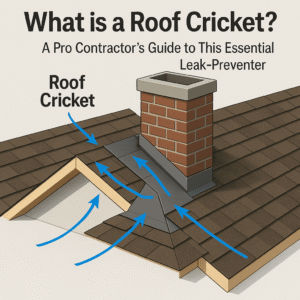What is a Roof Cricket? A Pro Contractor’s Guide to This Essential Leak-Preventer
What is a Roof Cricket?
A roof cricket, also known as a saddle, is a small, peaked structure built on the high side (back) of a chimney or other wide roof penetration. Its sole purpose is to divert water, snow, and debris around the obstacle, preventing a “dead spot” where moisture can pool and cause catastrophic leaks and structural rot. In the U.S., building codes often require a cricket for any chimney wider than 30 inches.
A few years ago, I was called to a beautiful colonial home to investigate a persistent leak that had stumped two other contractors. The homeowner was frustrated, having spent nearly a thousand dollars on failed “fixes.” The water stains ran down the fireplace wall, and the attic smelled of damp wood. Within 30 seconds of getting on the roof, I knew the problem. Their massive, four-foot-wide brick chimney had no cricket. The back of the chimney had become a permanent swamp, and water had finally rotted its way through the decking. The eventual repair cost over $7,000—all because a small, crucial structure was missing.
A roof cricket is one of the most important structures on your roof that you’ve probably never heard of. It’s a simple concept with a massive impact, turning a roof’s biggest vulnerability into a fortress against water. In this guide, we’ll cover what a cricket is, the science of why it’s necessary, when it’s required by law, how it’s built, and how to spot problems with your own.
The Physics of Failure: Why Wide Chimneys Create a “Dam”
To understand why a cricket is so essential, you have to think like water. Water on a sloped roof flows downhill, following the path of least resistance. When it encounters a small obstacle, like a plumbing vent, it flows around it easily.
However, when water hits a wide, flat obstacle like the back of a chimney, it stops. It can’t go through, so it pools up, creating a small pond on your roof. This standing water, combined with accumulating leaves, pine needles, snow, and ice, creates a high-pressure “dead spot.” Even the best flashing and sealants will eventually fail under this constant assault of saturation and freeze-thaw cycles. It’s not a matter of *if* it will leak, but *when*.
This is a completely different challenge than managing water on other roof types. For example, the design of flat roofs must account for drainage across the entire surface, while a sloped roof relies on shedding water quickly.
The Cricket Solution: A Roof for Your Roof
A roof cricket is an elegant and simple solution to this “damming” problem. It’s essentially a small, double-sided gable roof built directly behind the chimney, with its peak pointing towards the ridge of the main roof.
This mini-roof performs one critical job: **it diverts the water.** Instead of hitting a flat wall, the water now hits the angled planes of the cricket and is safely channeled to either side of the chimney, where it can continue its journey down the roof and into the gutters. It effectively eliminates the dead spot, ensuring no water can pool and saturate the most vulnerable area of your roof. It also prevents heavy snow and ice from building up directly against the chimney, which can cause significant damage during winter.
Building Code Requirement: The 30-Inch Rule
A roof cricket is not just a “good idea”—it’s often the law. The International Residential Code (IRC), which most U.S. municipalities use as a basis for their building codes, states in Section R1001.6:
“A cricket or saddle shall be installed on the ridge side of any chimney or penetration more than 30 inches (762 mm) wide as measured perpendicular to the slope. The cricket or saddle shall be sheet metal or of the same material as the roof covering.”
This means if the backside of your chimney is wider than 30 inches, a cricket is mandatory for your roof to be code-compliant. Failure to have one can result in failed inspections and potential issues with insurance claims, a serious concern for homeowners wondering what happens if they don’t use insurance money for repairs.
Anatomy of a Cricket: How It’s Built and Waterproofed
A properly constructed cricket is a multi-layered system that requires skills in framing, sheathing, and advanced waterproofing. It’s a miniature version of your main roof.
1. Framing
The skeleton of the cricket is built with wood, typically 2x4s. A small ridge board runs from the back of the chimney up towards the main roof peak, and angled rafters run from this ridge down to the roof deck on either side, creating the triangular shape.
2. Sheathing
Just like a real roof, this frame is then covered with sheathing, usually a piece of OSB or plywood cut to fit perfectly. This creates the solid surface for the waterproofing layers.
3. Underlayment
This is the first and most critical layer of waterproofing. A high-quality, self-adhering ice and water shield is applied over the sheathing and wrapped up the side of the chimney. This creates a seamless, waterproof membrane that acts as a final line of defense.
4. Flashing & Shingles
This is where true craftsmanship comes in. A complex system of metal roof flashing is installed over the underlayment, integrating the cricket with both the chimney and the main roof deck. Finally, the cricket is covered with shingles or metal panels to match the rest of the roof.
The complexity of integrating a cricket is why it is best left to professionals, especially on complex materials. Knowing if you can walk on a metal roof safely to inspect or build a cricket is a skill in itself.
DIY Cricket Repair vs. Professional Build
While some minor roofing tasks can be handled by a savvy DIYer, building or replacing a roof cricket is not one of them. The geometry is complex, and the waterproofing details are unforgiving. A single mistake in the flashing can channel water *into* your home instead of away from it.
However, a homeowner *can* perform basic maintenance. If the sealant at the edge of the cricket’s flashing is cracked or peeling, carefully removing the old caulk and applying a fresh bead of professional-grade sealant is a smart, proactive repair. But if the metal is rusted or the structure is failing, it’s time to call in a pro.
Tools of the Trade for Cricket Construction & Maintenance
A professional relies on quality tools to build a cricket that lasts. For serious DIYers looking to tackle other advanced projects or perform minor sealant maintenance, these are the types of tools to have on hand.
1. Precision Cutting: DEWALT 20V MAX Circular Saw
Building a cricket requires precise angled cuts for the framing and sheathing. A reliable, powerful circular saw is essential. This cordless model from DEWALT provides the power and freedom of movement needed to work efficiently and accurately on a rooftop.
Check Price on Amazon2. Metal Forming: Midwest Aviation Snips
The flashing is the most intricate part of the job. A high-quality set of aviation snips (left-cut, right-cut, and straight) is non-negotiable for cutting and shaping galvanized steel or aluminum flashing to create the tight, custom fit required for a waterproof seal.
Check Price on Amazon3. Professional Waterproofing: Geocel 2300 Sealant
The final seal is critical. This is the best roof sealant that professionals trust. It adheres to almost any surface, stays permanently flexible to accommodate expansion and contraction, and can even be applied in wet conditions. It’s the perfect product for sealing the final seams of your cricket flashing.
Check Price on AmazonFrequently Asked Questions About Roof Crickets
What is the difference between a roof cricket and a saddle?
They are two names for the same thing. “Cricket” and “saddle” are used interchangeably in the roofing industry to describe the water-diverting structure built behind a chimney.
How much does it cost to have a roof cricket built?
The cost to build a cricket can vary widely based on the size of the chimney, the type of roofing material, and local labor rates. For a standard asphalt shingle roof, you can expect to pay between $500 and $2,500+ to have a cricket retrofitted. While it may seem expensive, it’s a fraction of the cost of the water damage it prevents.
Do skylights or vents need crickets?
Generally, no. Most modern skylights and vents come with their own integrated flashing kits designed to shed water effectively. However, very large, wide curb-mounted skylights might require a cricket, per the same 30-inch rule that applies to chimneys.
How does a cricket affect pests?
A properly built and flashed cricket is actually a great pest deterrent. The tight metal flashing helps seal the large gap that would otherwise exist between the chimney and the roof deck. This makes it much harder for pests to get in, which is a key concern for homeowners who know that roof rats are dangerous. It also eliminates a prime nesting spot for birds, though you may still need the best bird spikes on the chimney cap itself.
Final Verdict: A Small Structure with a Mighty Purpose
A roof cricket is a perfect example of a small detail that makes a world of difference. It’s not a cosmetic upgrade; it’s a critical piece of engineering required by code to protect the most vulnerable point on many roofs. The damming effect of a wide chimney is a guaranteed leak waiting to happen, and the cricket is the only permanent solution.
If you have a chimney wider than 30 inches and no cricket, a professional inspection should be your next call. The cost of building one correctly is an investment in the long-term health and integrity of your home. It’s the kind of smart, proactive decision that prevents you from having to make a frantic call to a roofer in the middle of a rainstorm.





